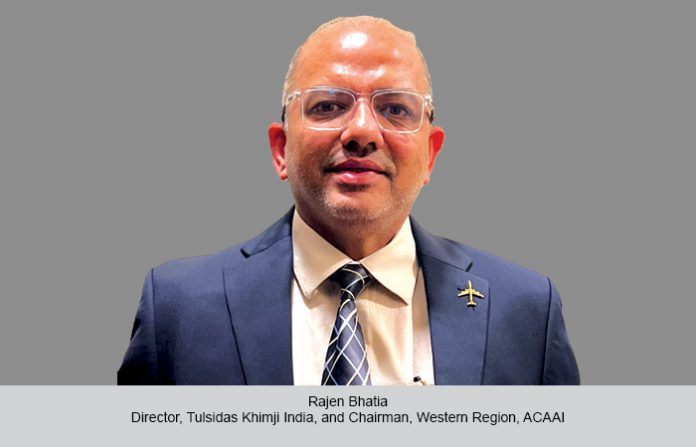Trying to become a global cargo hub, Mumbai’s transformation comes with its share of challenges. From congestion at airports to outdated infra and complex regulations—Mumbai is overcoming them by investing in logistics capabilities, and streamlining customs, says Rajen Bhatia, Director, Tulsidas Khimji India.
CT Bureau
Infrastructure issues such as road congestion, limited multimodal connectivity, and delays affect cargo operations in Mumbai in several ways. Due to road congestion in Mumbai, cargo trucks get stuck in traffic and experience delays prolonging the transit times. This leads to missed deadlines, resulting in late deliveries, unhappy clients, and disruptions in supply chains.
Road congestion
Heavy traffic leads to increase in fuel consumption and higher operational costs. The capacity of airport and port is limited and, whenever there is a slight surge in volume, there is road congestion and vehicles await their turn patiently to get offloaded. The entry
and exit points procedure is cumbersome as it is controlled by CISF. Breakdown in
online system is one of the reasons for affecting congestion and leading to delay in
cargo operations.
The lack of rail facility within the port areas is affecting faster and economic movement. In conclusion, congestion at ports and airports—regardless of how minor the surge in volume is—can create a cascading effect of delays, higher costs, and supply chain inefficiencies that hurt businesses and disrupt the flow of goods, particularly in critical, fast-paced markets such as Mumbai.
Multimodal logistics hurdles
In Mumbai, cargo is moved either via ports such as Jawaharlal Nehru Port Trust (JNPT) and Chhatrapati Shivaji Maharaj International Airport (CSMIA). As far as air cargo is concerned, capacity is the main issue. The growing demand for air freight, combined with limited capacity in the cargo terminals, leads to overcrowded storage areas, causing delays in dispatch or delivery of goods. The industrial area is scattered, far from both airport and port. Absence of dedicated roads hinders the smooth flow of traffic to port and airport. While Mumbai’s ports and airport are well-connected to road transport networks, the integration with rail or inland waterways is often inefficient. This limits the ability to transfer goods between different modes of transport, causing delays, especially when trucking is the only viable option.
Need smart warehouses
The lack of sufficient modern warehousing facilities at the airport and the ports exacerbates logistical issues. The availability of cargo storage space can be a bottleneck, especially during peak shipping seasons. Coordinating the transfer of goods from one mode of transport to another is time-consuming and inefficient due to poorly designed infrastructure and limited availability of specialised equipment. Port-related logistics often involve long clearance times due to inefficient customs procedures or lack of automation.
Reliance on paperwork
Manual documentation, inspections, and compliance checks can slow down cargo movement, especially for time-sensitive goods. The reliance on paper-based documentation at ports and airports causes delays. Frequent inspections of goods and delays in processing clearance paperwork can affect overall transit times. Frequent changes in trade policies, tariffs, compliances being introduced on a regular basis defeats the purpose of EoDB. On top of this, customs regulations can create confusion and delays, as logistics operators scramble to comply with new rules or requirements.
Cargo security
Thefts can occur during long delays on the road between ports, airport and warehouses. Heightened security measures, especially after terror attacks or natural disasters, can slow down cargo handling at ports and airport. Additional checks, screenings, and compliance measures also take up valuable time.
Monsoon troubles
Mumbai experiences heavy rains and flooding during the monsoon season (June to September), which can cause delays in port and airport operations. Port operations can be suspended due to weather conditions, and air traffic may be disrupted due to reduced visibility or runway flooding.
Shortage of skilled workers
The logistics sector faces a shortage of skilled labour, including truck drivers and port workers. The lack of training and expertise can slow down operations, contribute to human errors, and affect efficiency of goods movement. The lack of standardised procedures for handling goods, especially for specialised cargo, can lead to mistakes causing delays or damages to goods. Unavailability of specialised handling equipment leads to damages and delay causing cost effectiveness.
18% GST on air freight
Implementation of 18 per cent GST on air freight has impacted freight forwarding process in Mumbai. While the introduction of GST was intended to streamline India’s indirect tax structure and create a unified tax environment, its impact on forwarding operations has been mixed, especially in high-traffic regions such as Mumbai. It has increased the cost of moving goods by air, especially global shipments. Forwarding firms will now have to bear the additional tax burden, which they pass on to customers. This has led to an increase in the overall cost of air cargo services, particularly for businesses that rely on air freight for time-sensitive shipments.
Forwarding firms need to pay the GST upfront on services rendered, which can lead to cash flow issues, especially for small and medium-sized businesses. While they can claim input tax credits (ITC) later, the upfront cost of 18 per cent GST impacts the working capital of logistics providers. Freight forwarders across India have been forced to enhance their understanding of GST compliance, for services they provide (air freight) and for the broader logistics chain (customs and warehousing, among others).
Was NLP beneficial?
For a logistics hub such as Mumbai that handles cargo volumes through its ports, airports, and road networks, the impact of the policy has been transformative in several ways. One of the major components of the NLP is the development of Dedicated Freight Corridors, particularly the Mumbai-Delhi Freight Corridor. These corridors help improve the speed and efficiency of rail-based freight transportation, directly reducing congestion on roads and lowering transportation costs for businesses moving goods between key industrial hubs. The policy’s push for better multimodal connectivity (rail, road, ports, and airports) has led to investments in projects such as Mumbai Trans Harbour Link, which aims to ease congestion around the city’s ports. These infrastructure improvements enhance flow of goods in and out of Mumbai, reducing delays and bottlenecks, especially at JNPT.
The NLP aims to upgrade port facilities and ensure faster TAT for ships, reduce congestion at ports, and improve inland connectivity. These upgrades focus on modernising cargo handling processes, expanding capacity, and making ports competitive on a global scale. Mumbai’s ports such as JNPT, benefit from these infrastructure improvements, resulting in reduced waiting times for vessels, faster cargo handling, and better utilisation of port facilities. This enhances Mumbai’s role as a major global gateway and reduces port-related delays for the freight forwarders.
By improving efficiency and optimising SCM, the policy aims to lower costs for businesses across industries. The NLP encourages a unified logistics market by standardising logistics processes across India and making it easier for businesses to engage in cross-state trade.













